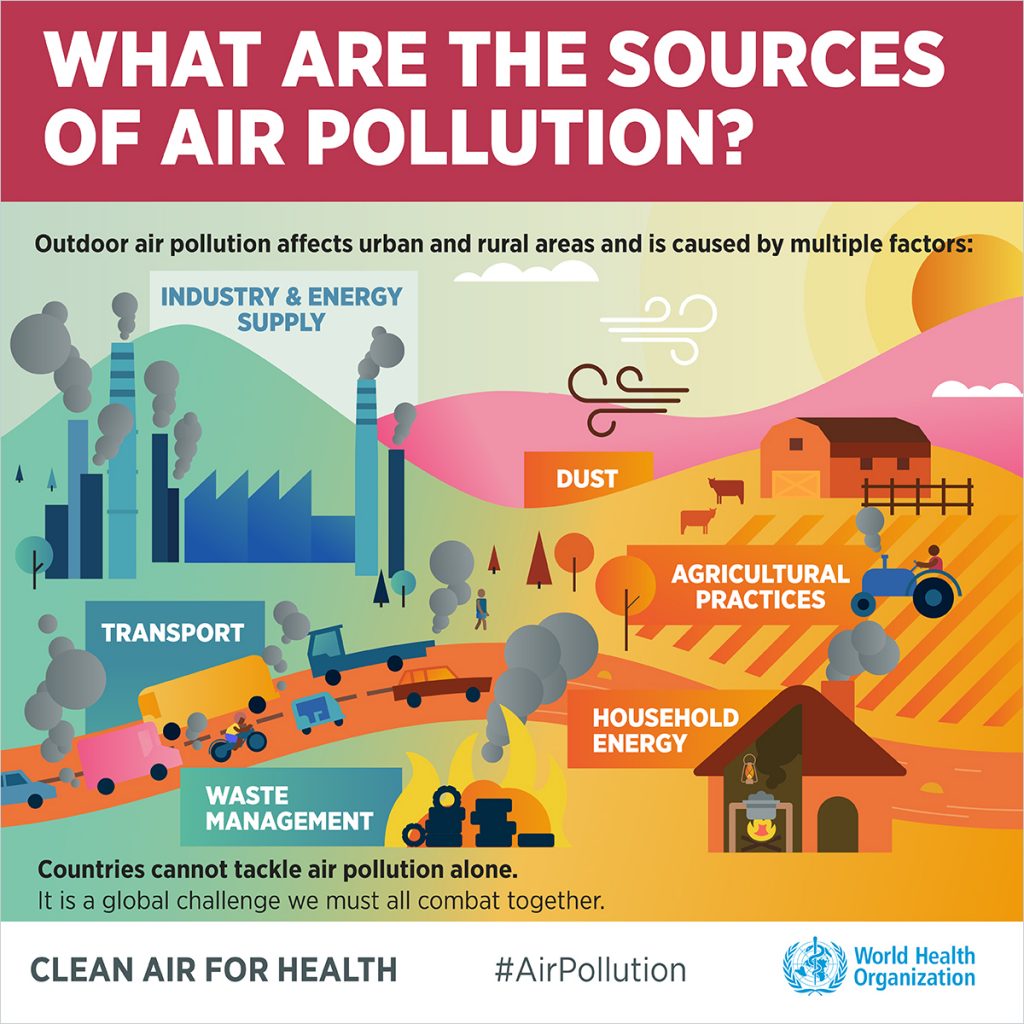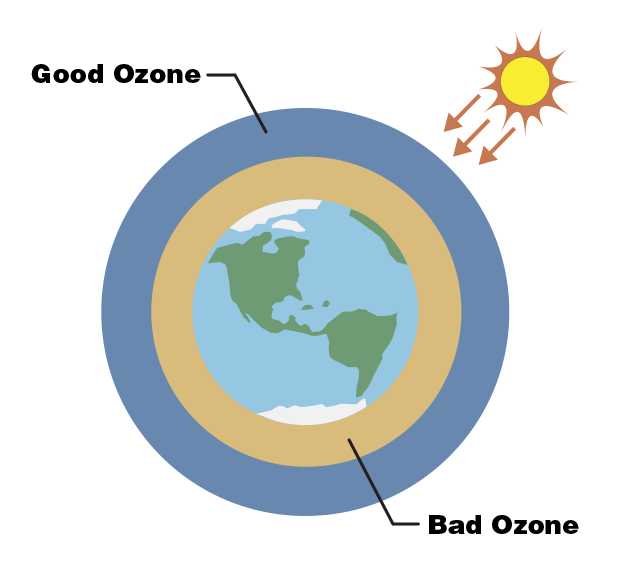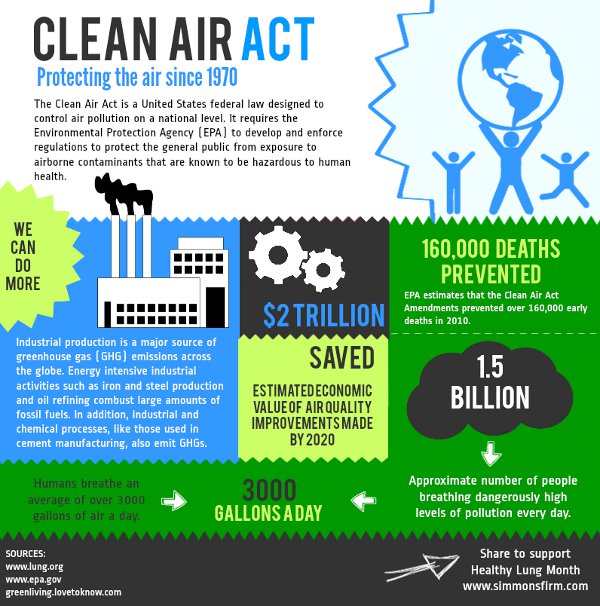What is Air Pollution?
Air pollution is a mix of solid and liquid particles and gases that can reach harmful concentrations both outside and indoors. These particles and gases are bad for the planet and for our health, so keeping track of them is important. Soot, smoke, mold, pollen, methane, and carbon dioxide are just a few examples of common air pollutants.
Furthermore, carbon monoxide, nitrogen oxides, ozone, particulate matter, sulfur dioxide, and lead are all regulated under the Clean Air Act of 1970. 1Judith A. Layzer and Sara R. Rinfret, The Environmental Case: Translating Values Into Policy, Fifth edition (Los Angeles: CQ Press, 2019).

Where Does Air Pollution Come From?
Air pollutants are released into the air from both man-made and natural sources including:
- Burning of fossil fuels during electricity generation, transport, industry and households
- Industries, like chemical production and mining
- Agriculture
- Landfills
- Natural sources, including volcanic eruptions, windblown dust, sea-salt spray and emissions of volatile organic compounds (VOCs) from plants, paint, and gasoline. 2“Sources of Pollution – Clear the Air, a Learning Resource in Scotland,” accessed April 19, 2020, http://cleartheair.scottishairquality.scot/about/sources.
Good Up High, Bad Nearby – What is Ozone?
Ozone high up in our atmosphere (found in the stratosphere) is a good thing. It helps block harmful energy from the sun, called radiation. But, when ozone is closer to the ground (found in the troposphere), it can be really bad for our health. Ground-level ozone is created when sunlight reacts with certain chemicals that come from burning fossil fuels.3“What Causes Air Pollution?,” NASA Climate Kids, accessed April 19, 2020, https://climatekids.nasa.gov/air-pollution/.
When particles in the air combine with ozone, they create smog. Smog looks like smoky fog and makes it difficult to see.4“What Causes Air Pollution?” Smog contributes to respiratory problems, such as asthma.


Policy Process of the Clean Air Act of 1970

Who are the policy entrepreneurs and what actions have they taken? Numerous policy entrepreneurs, such as public citizens, the EPA, Congress, and President Nixon, fueled the implementation of the Clean Air Act of 1970. Public support for air pollution regulation was one of the first steps in creating the Clean Air Act. In the late 1960s, there was a mass environmental movement, with citizens pushing for reductions in air pollution.19Layzer and Rinfret, The Environmental Case. In response, President Nixon and Congress began to work on a policy that would address these air pollution concerns. When the EPA was established in 1970, the EPA assumed responsibility for setting air quality standards and ensuring that states enforced these standards.20Rosenbaum, Environmental Politics and Policy. President Nixon invested time and political resources into this policy, and on December 31st, 1970, the Clean Air Act was passed.21Rosenbaum.
Which phases of the policy process model are most relevant to this case, and why? The most relevant phases of the policy process model are policy evaluation and policy change. Since the Clean Air Act was implemented in 1970, there have been numerous modifications to meet the policy’s initial goals. Congress made changes to the policy in the Clean Air Act Amendments of 1977, adding more stringent regulations on auto and truck emissions.22Rosenbaum. Furthermore, Congress and President George H. W. Bush established the Clean Air Act Amendments of 1990, which aimed to regulate emission of NOx and SO4.23Rosenbaum.The EPA must continue to evaluate the Clean Air Act and determine whether the United States is meeting its intended goals in regards to air pollution.
How are the policy, problem, and political streams relevant to this case? Policy stream: At the time, there was a lack of federal air regulations, presenting an opportunity for the United States to implement a policy to govern air quality across the country. The Clean Air Act of 1970 was presented as a viable option. Problem stream: Air pollution is a serious problem in the United States and across the world. In the late 1960s, this issue was especially prevalent due to the industrial revolution. This problem needed to be addressed in order to reduce pollutants in the atmosphere. Political stream: Not only was the problem of air pollution super visible to people across America, but President Nixon was also highlighting it on the campaign trail. Since it was an election year, Nixon promised to regulate air pollution to attract voters.
What policy windows are relevant to this case? The mass environmental movement at the end of the 1960s opened a policy window that was needed to implement the Clean Air Act of 1970. Environmental writers and activists redefined environmental issues, sparking public interest in pollution.24Layzer and Rinfret. In 1969, a series of highly publicized environmental disasters hit, further involving citizens in environmental issues.25Layzer and Rinfret. Finally, the introduction of Earth Day in 1970 was a tipping point in environmental activism. Earth Day fueled a movement aimed at improving environmental conditions. The policymakers were required to respond to public demands; therefore, the movement presented a policy window for the implementation of the Clean Air Act of 1970.
What is the Status of Air Pollution Around the World?
From smog hanging over cities to smoke inside the home, air pollution poses a major threat to health and climate. Air pollution kills an estimated seven million people worldwide every year, and WHO data shows that 9 out of 10 people breathe air containing high levels of pollutants.26World Health Organization, “Air Pollution,” accessed April 19, 2020, https://www.who.int/westernpacific/health-topics/air-pollution.More than 80% of people living in urban areas that monitor air pollution are exposed to air quality levels that exceed WHO guideline limits, with low- and middle-income countries suffering from the highest exposures, both indoors and outdoors.27World Health Organization. Here is a link to view global air quality data: https://waqi.info/

What is the Status of Air Pollution in the United States?
Since 1970, implementation of the Clean Air Act and technological advances from American innovators have dramatically improved air quality in the U.S. Cleaner air provides important public health benefits. According to the EPA, there has been approximately a 50% decline emissions of key air pollutants since 1990.28U.S. EPA Office of Air and Radiation, “Air Quality Trends Show Clean Air Progress,” accessed April 19, 2020, https://gispub.epa.gov/air/trendsreport/2019/.
However, according to “State of the Air 2019,” the American Lung Association’s 20th annual report, more than 40 percent of Americans live in areas with unhealthy air.29American Lung Association, “State of the Air 2019,” 2019, https://www.lung.org/assets/documents/healthy-air/state-of-the-air/sota-2019-full.pdf. Harold Wimmer, the group’s president and CEO, said that after years of progress, there’s clear evidence of a “disturbing trend,” with many Americans seeing their air quality worsening due to wildfires and weather patterns. Climate change is fueling that trend, he said. While legislation like the Clean Air Act has reduced the amount of air pollution on a national scale, many parts of the country are battling the harmful effects of air pollution.
What is the Status of Air Pollution in Mecklenburg County, NC?
According to the American Lung Association’s “State of the Air 2019,” Charlotte Metro residents in Mecklenburg County are subjected to unhealthy amounts of ground-level ozone.30American Lung Association. When it comes to the number of high smog days in North Carolina, 16 counties received “A” grades and only one county — Mecklenburg County — received a failing grade. While Mecklenburg County received an ‘F’ for ozone pollution, it did make the organization’s list of cleanest U.S. cities for short-term particle pollution.
Here is a link to view the current air quality index in Mecklenburg County: https://www.mecknc.gov/LUESA/AirQuality/AirQualityData/Pages/default.aspx
In early 2018, the Charlotte City Council invited local leaders from the environmental, health, faith, justice, business, and government sectors to provide input on a suite of climate-related policies and commitments that eventually became the Sustainable and Resilient Charlotte by 2050 Resolution and the Strategic Energy Action Plan (SEAP).

Take Action!
Actions you can take to reduce air pollution in general:
On Days when High Ozone Levels are Expected, Take these Extra Steps:
Organizations that work on air pollution that you can support:
- Conserve energy – at home, at work, everywhere.
- Look for the ENERGY STAR label when buying home or office equipment.
- Carpool, use public transportation, bike, or walk whenever possible.
- Follow gasoline refueling instructions for efficient vapor recovery, being careful not to spill fuel and to tighten your gas cap securely.
- Use environmentally safe paints and cleaning products whenever possible.
- Mulch or compost leaves and yard waste.
- Choose a cleaner commute – share a ride to work or use public transportation.
- Combine errands and reduce trips. Walk to errands when possible.
- Avoid excessive idling of your automobile.
- Refuel your car in the evening when it’s cooler.
- Conserve electricity and set air conditioners no lower than 78 degrees.
- Defer lawn and gardening chores that use gasoline-powered equipment, or wait until evening.31U.S. Environmental Protection Agency, “Actions You Can Take to Reduce Air Pollution,” September 27, 2018, https://www3.epa.gov/region1/airquality/reducepollution.html.
- Clean Air Carolina—its mission is to ensure cleaner air quality for all North Carolinians through education and advocacy and by working with partners to reduce sources of pollution.
- The World Health Organization (WHO) monitors health effects from air pollution across the world. They record data for ambient air pollution and household air pollution. In addition, they track cities and determine whether they exceed WHO guideline limits for pollutants.
Learn More!
For more information on the difference between “good” vs. “bad” ozone: https://cfpub.epa.gov/airnow/index.cfm?action=gooduphigh.index
For more information on ozone pollution in North Carolina, visit: https://www.lung.org/media/press-releases/state-of-the-air-2018-nc
NASA’s Climate Kids Website: https://climatekids.nasa.gov/air-pollution/
National Geographic’s page on Air Pollution: https://www.nationalgeographic.com/environment/global-warming/pollution/






I learned that air pollution is mixed with solid, liquid particles, and gases they are harmful to the indoors and outdoors.
I learned that in the troposphere the is a bad ozone and in the stratosphere there is good ozone